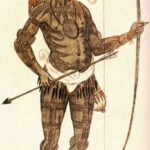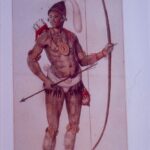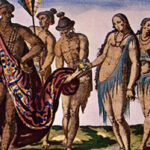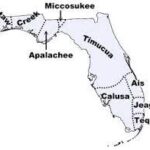Timucuan Indians are the copper colored or swarthy Tamerikhans (Tameri-Khans) depicted on the 1657 map of La floridas which has the Nationality of Tamerikaans listed under the plaque of La Floridas on this map.










Additionally, Timucuan are Tamerikhan are etymologically and phonetically the same word due to similar spelling and similar pronunciation. However, let’s break it down even further since the root of Timucuan is Timu (Tame), which is short for Tameri since the vowels are sacred and interchangeable, and were sometimes omitted in words.
The suffix of Timucuan is Cuan, which is obviously Khan since the letters C and U in Cuan are equivalent to the letters K and H in Khan, and these two letters can be substituted because they are interchangeable, like vowels. Therefore, when you combine the prefix and the suffix of Timu-cuan you will form the word Tamerikhan using my breakdown or interpretation. Khan (Can) is an Asian title that means king or priest.
Tamerikhan is one of the root-words of America. For example, T-ameri-khan is American if you remove the letter T from in front of the word Tamerikhan. Tameri or Amaru (T-amaru) is derived from the Sumerian god Amurru. Tameri is also an old name for Egypt, and it relates to Ethiopia Superior, aka, Abyssinia, and Assyrian, which was the huge landmass known as La floridas (Tameri or Ethiopia), La Louisiana (Acadian=Akkadian= Sumerian, Assyrian & Babylonian), and Carolana (Black land). Tameri also means the land of the Maurs or the land of Mary: https://www.americaistheoldworld.com/nineveh-was-jacksonville-florida/
The blog post shared above, “Jacksonville is Nineveh,” proves that Jacksonville, Florida was the Biblical Nineveh (Assyria), and it proves everything stated in the above paragraph. In the said blog post is a map of the Original Garden of Eden that designates the State of Florida as the Biblical Ethiopia (Abyssinia) and Assyria.
The Timucuan Indians had a vast territory of land that covered most of North Florida and central Florida, prior to the Spanish invasion of Florida in the 1500’s, as you can see by viewing the map of the territory of the Timucuan Indians. The territory of Timucua included Jacksonville, Saint Augustine, Callahan, Tampa, Orlando, etc.
The Timucuan were the first Natives of Florida, and they were a race of giants. The average height for the Timucuan man was between 7 and 8 feet tall. The average lifespan of the Timucuan Indians was between 300 and 350 years, according to Dr. Longo’s video from the YouTube channel “Old World Florida” entitled, “Hurricane Special: Audio Didactic + Dr. Longo”: https://www.youtube.com/watch?v=IMBQ8Er7Eg0.
Dr. Longo and I believe that the reason the Timucuan Indians were able to live for so long was due to a healthy diet and the fresh spring water from the Fountain of Youth located in Saint Augustine, Florida, which is in Timucuan territory (Ethiopia and Assyria).
Saint Augustine, Florida is the oldest city in America, allegedly founded by the Spanish in the Early 1500’s during the Spanish invasion. However, the problem with this academic lie is that “An archaeological dig in St. Augustine in 2006 revealed a Timucuan site dating back to between 1100 and 1300 AD, predating the European founding of the city by more than two centuries. Included in the discovery were pottery, with pieces from the Macon, Georgia area, indicating an expansive trade network; and two human skeletons. It is the oldest archaeological site in the city.[8]” [end quote from: https://en.wikipedia.org/wiki/Timucua].
This means that the Venetian (Phoenician) Gothic Architecture (Moorish or Tartarian architecture) that use to cover Saint Augustine, Jacksonville, and all of Florida, was built prior to the Spanish invasion of the 1500’s by the Maurs or the Tamerikhans if you hate the term Maur.
One of the master builders of Prester John’s Kingdom of India Superior/ Ethiopia Superior (Abyssinia or La Floridas) was Saint Thomas the Apostle, the Patron saint of India, who was a magi (magician) that built some of these Gothic structures with the use of magic. “Gothic comes from goetia (‘to elevate by magical force’), whose extension is goeteuein (‘to bewitch’)”. Gothic Architecture is also a Moorish or a Tartarian mode of workmanship, according to the textbook, “A Dictionary of the Architecture and Archaeology of the Middle Ages.” Gothic building is also Castle building that comes from Ethiopia since the oldest castles are in Ethiopia, but which Ethiopia since it was three of them? We have a connection to Ethiopia since Tameri (La Floridas) is Ethiopia Superior and India Superior, aka, the land of the Maurs or Moorenland, which means the country of the Maurs. Ethiopia was Moorenland, according to the definition from Webster’s Dictionary.
The Emperor of Ethiopia Superior (Abyssinia) or La Floridas was Prester John (Saint John). This blog post has a map with Prester John being designated as the Emperor of Abyssinia and Ethiopia Superior. In this post is a painting of Prester John that designates him as the Emperor of Abyssinia and it shows him holding the Phoenician Taw (X) in his hand and wearing green and red, which are the colors of the Maurs (Saracens) and Israel: https://www.americaistheoldworld.com/the-greater-morocco-was-in-the-americas/.
I love the little Dwarf, Smurf, Pygmy, or Leprechaun in the painting that his holding the magical mirror of Prester John that allowed him to see all the events in the world. Prester John was also the Emperor of India and the King of the Tartars (Tartarians), etc. One of my favorite titles that Prester had was the Green man and the Green Knight, since there is an enchanted Green Swamp near his magical kingdom in Walt Disney World Florida: https://www.americaistheoldworld.com/marrakesh-was-orlando/.
Prester John, aka, King David El (the Biblical line of King David) is also associated with the Fountain of Youth that he established in his kingdom in Ethiopia that he bragged about drinking from six times in his famous letter from the year 1165 that went to every ruler in the world, so Prester John correlates with the Timucuan Indians long life span, since Prester John was also known as the immortal priest King since he lived to be over 560 years old; however, some sources say he lived to be over 1200 years old since he had contact with before Christ era Kings like Xerxes and Alexander the Great, who were mere pawns to this powerful Magi King.
Other titles of Prester John: John the Baptish of Bible (Fountain of Youth), Melchizedek (Thoth), Prophet Elijah, Enoch (Thoth), the Fisher King, King of Kings, the Negus (Pharoah), Angel Gabriel (Thoth), Lord Shiva, Enki, Lord of the Rings, Lord of the seen and unseen worlds, King Merovech (founder of the Merovingian Dynasty), the dragon king, the dragon Emperor, the Grand Khan, the Khan father, the Highlander, the King of the Scots, King of the Orient, Grand Master of the Knights Templars, the Knight of the Serpent, the King Knight, the giant slayer, and etc.
The Spanish conquerors described the Timucuan people as Pictish (Picts) in appearance. We know that the ancient Picts of Scotland and Ireland were Swarthy (Black) people from the Iberian Peninsula, according to Romain Historian Pliny.
You can also see post images of the Timucuan people and as you can see, they were swarthy Maurs/ Muurs (Moors) from the land of the Maurs, Tameri or Ethiopia Superior (Abyssinia) in La Floridas. The Timucuan Indians in the images are mostly wearing turbans, which is a Hebrew and Moorish tradition or custom. Dr. Longo whitewashed the Timucuan Indians and other Indian tribes in his video, so please avoid the hijack when viewing it.
But what if La Florida was the original Iberian Peninsula? My blog post, “Gibraltar of the West,” demonstrates that Florida was the original Iberian Peninsula, home of the Garden of Eden, home of the Fountain of Youth, home of the Garden of Hesperides, and the Original Barbery Coast: https://www.americaistheoldworld.com/gibraltar-of-the-west/.
The Timucuan Indians were the Ethiopians and the Assyrians of Florida:
“The Timucua were a Native American people who lived in Northeast and North Central Florida and southeast Georgia. They were the largest indigenous group in that area and consisted of about 35 chiefdoms, many leading thousands of people. The various groups of Timucua spoke several dialects of the Timucua language. At the time of European contact, Timucuan speakers occupied about 19,200 square miles (50,000 km2) in the present-day states of Florida and Georgia, with an estimated population of 200,000. Milanich notes that the population density calculated from those figures, 10.4 per square mile (4.0/km2) is close to the population densities calculated by other authors for the Bahamas and for Hispaniola at the time of first European contact.[1][2] The territory occupied by Timucua speakers stretched from the Altamaha River and Cumberland Island in present-day Georgia as far south as Lake George in central Florida, and from the Atlantic Ocean west to the Aucilla River in the Florida Panhandle, though it reached the Gulf of Mexico at no more than a couple of points.
The name “Timucua” (recorded by the French as Thimogona but this is likely a misprint for Thimogoua) came from the exonym used by the Saturiwa (of what is now Jacksonville) to refer to the Utina, another group to the west of the St. Johns River. The Spanish came to use the term more broadly for other peoples in the area.[3] Eventually it became the common term for all peoples who spoke what is known as Timucuan.
While alliances and confederacies arose between the chiefdoms from time to time, the Timucua were never organized into a single political unit.[2] The various groups of Timucua speakers practiced several different cultural traditions.[4] The people suffered severely from the introduction of Eurasian infectious diseases. By 1595, their population was estimated to have been reduced from 200,000 to 50,000 and thirteen chiefdoms remained. By 1700, the population of the tribe had been reduced to an estimated 1,000 due to slave raids from Carolinian settlers and their Indian allies. The local slave trade completed their extinction as a tribe soon after the turn of the 18th century.” [end quote from: https://en.wikipedia.org/wiki/Timucua].
The fact that the Timucuan Indians experienced the Slave trade is further evidence that the Timucuan Indians were Negroes or Black people, since they were able to blend in with the dark slaves that were allegedly brought from Africa.
Based upon the above evidence, the Timucuan Indians were also the Tamerikhans (Ethiopians and Assyrians) and their Emperor was Prester John, aka, John the Baptist, since the Timucuan Territory is in his magical kingdom of Ethiopia Superior (Abyssinia).
Please donate to my Cashapp at $Amunhotep7 since your donations help with travel and research. I thank you for your time and support and enjoy. Peace.
The post Timucuan Indians are the Tamerikhans appeared first on America is the Old World.
source https://www.americaistheoldworld.com/timucuan-indians-are-the-tamerikhans/?utm_source=rss&utm_medium=rss&utm_campaign=timucuan-indians-are-the-tamerikhans




No comments:
Post a Comment